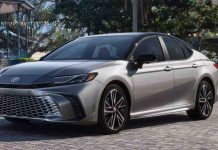If you like the “electronic experience” — iDrive mouse controller, lots of LCD screens and menus to scroll through to change the radio or adjust the air conditioner — BMW’s M roadster might not be your thing. But if the distilled, no-BS essence of “BMW-ness” — a perfectly balanced chassis, big-power engine and, most important of all, shift-for-yourself six-speed gearbox are what does it for you — then you’ll gladly sign away your first born in exchange for some seat time in the M roadster.
The M roadster is the souped-up version of BMW’s Z4 roadster and it (as well as a hardtop coupe version) are just now becoming available on the retail end of the pipeline — with a base price of $51,300 for the soft-top roadster and $49,300 for the hardtop coupe.
Yes, it’s a fairly mighty frog-hop from the base price of the standard Z4 — which carries a sticker of $35,600( $40,100 for the hardtop). But what you get for the extra $10-15k is worth every second mortgage penny.
All the go-really-fast goodies that make an M3 (the hot-shoe version of BMW’s four-seater 3-Series) one of the most formidable street cars on the road are now to be found in the Z4’s more purposeful two-seater shell — including the same basic 3.2 liter straight six (rated at 330-hp in the M roadtser/coupe) and six-speed manual transmission. There is no automatic option — not even a semi-automatic option (BMW’s computer-controlled, “clutclhess” Sequential Manual Gearbox) as in the M5 sedan.
This car is all about the elemental experience of fast-moving — as the driver, not a spectator shoved to the side by know-better electronics. You rev the 8,000 RPM twin-cam terror to the sweet spot and dump the clutch; you deftly blip the throttle as you slice the box from first to second — manfully barking the tires as you go. The SMG may be more efficient — or at least, more consistent. But rowing your own is what connects the driver to the car.
Also, the M’s DSC traction/stability control system can be turned off (and stays off) with a simple one-time push of the little button on the center console. No computer second-guesses your ability — even when during tail-out drifts through decreasing radius hairpins. You can lose it in the M coupe/roadster — and that is part of the allure. Sort of like petting a tiger (or a date with a diva supermodel).
For those who want a car that doesn’t just have high limits — but which actually lets you test your own limits — this Beemer delivers the package total.
In some respects, it’s even a more civilized experience than you get in the mechanically similar M3 — especially in terms of the chassis tuning. Anyone who has driven an M3 knows it’s as firm and unforgiving as Brigitte Nielsen during her late ’80s prime. Great for track days — hideously punishing as a daily driver. Though the M roadster/coupe share almost identical bits and pieces, BMW dialed in a more compliant ride (especially with the “sport” button turned off) that’s as livable as any Miata’s. The difference in ride quality may also be due to the decrease in unsprung mass in the M coupe/roadster relative to the M3 — which weighs several hundred pounds more and so probably needed firmer calibrations to keep it all tied down.
Pressed hard, you might notice some body roll in situations where the M3 corners flatter, but the limits of grip are so high it’s a non-issue on the street — and probably wouldn’t make much of a difference even on an autocross circuit. Few cars can keep up with an M — just as there are few non-pro drivers who would be able to press the car to its limits before stepping well beyond their own.
A major area of departure — beyond just the mighty engine — from standard Z4s is the higher-effort, 4.7:1 ratio steering box (in place of the electric-assist unit used in the standard, non-M cars) and the car’s unique/proprietary Variable M differential lock, which BMW says is there to provide “optimum traction in curves.” Decoded, the M coupe/roadster’s differential works like a standard limited slip axle during straight line power drives to help both drive wheels bite into the tarmac (instead of having just one wheel spin furiously and uselessly, as sometimes happens with “open” rear ends tied to powerful drivetrains). But in cornering — especially one-the-edge high-speed cornering — the Variable M Differential Lock recognizes the differential in rotational speed building between the driven wheels (as happens in a corner, when the inside wheel is turning at a different rate than the outside wheel) and generates pressure in an integrated shear pump. This pressure activates a multiple plate clutch via a piston, and routes drive forces to the wheel with better grip, according to the difference in wheel rotation speed. In extreme cases, the engine’s entire drive force may be transmitted to the individual wheel with the better frictional coefficient.
End result? A noticeably ess snappy tail that doesn’t want to come around as readily as you might expect in such a short-wheelbase (98.3 inches) high-powered sports car — even when the “pucker factor” is beginning to get up there. You have to play with it yourself to get a sense of the car’s improved stability — and higher threshold of grip — relative to otherwise similar sports cars without the Variable M Differential. But once you get acquainted, you’ll never fly without it again. The system also does a magnificent job of keeping the tail planted and pointed in the right direction on those at-redline 1-2 (and 2-3) upshifts. Extremely powerful, lightweight cars like the M can get unsettled (and sometimes, sideways) during such maneuvers. The Variable diff keeps a lid on that — but without spoiling any of the hooligan fun in the way that over-intrusive electronic nannies increasingly do in cars of this type.
Such measures of performance are, of course, intimate get-to-know-you treats you’ll have to discover on your own; just you, the car — and your own favorite set of s-curves. It’ll be a date you’ll remember.
As far as the hard numbers: Zero to 60 takes just under 5 seconds and top speed is electronically limited to 155 mph. There are quicker/faster/cheaper alternatives (the Chevy Corvette, for one) but the M’s allure is its combination of very high performance, high-end import panache that the Joe Sixpack ‘Vette can’t touch — and an in-the-moment driving experience that few cars, irrespective of price, can equal. The absence of electronic clutter (no iDrive) and the manual-only diktat will appeal to the driver who just wants to get in and drive.
A few additional points should be mentioned as well. For some reason, the hardtop M coupe ($49,300) actually costs less than the M Roadster ($51,300), which is exactly the reverse of the case with the regular Z4s, where the base roadster starts out almost $5k less than the base hardtop. This is happy news for buyers who prefer the all-year security (and arguably, better lines) of the hardtop’s swoopy fastback shell.
The other noteworthy point about the M is the way the M-specific bodywork (including different front end/air dam, hood and rear valance panel with quad exhaust) spruce up (and clean up) the still-controversial “flame surfacing” look of the car. The side scalloping, for example, is nicely offset by the twin “power ridges” on the hood — and the 18-inch rims and huge Continental ZR-rated tires give the car that just-right squat.
The M coupe, with its fastback rear glass and discretely integrated ducktail spoiler is especially handsome.
Inside the M, it’s all business — but high-end business, like a tailored Fortune 500 executive’s suit or a set of custom fitted race leathers (for those of you into sport bikes). There’s a central cluster with 200-mph speedo (though you only get dots after 180 to indicate the next two 20 mph increments) and a big tach with variable redline (orange LEDs on the upper end of the range stay on until the engine’s full warmed up, after which you’re good to go to 8,000 RPM). Within the tach are a pair of smaller secondary analog gauges for fuel and oil temperature. Das ist alles. And what more do you need, really?
An M-specific trim feature is the optionally available “carbon leather” covering for the dash; it’s stretched tautly over its surface and provides a refreshing change from the over-used carbon fiber stuff that you see almost everywhere today — even on some el-cheapos in the $20k range. Heated seats are included in the base price — and GPS is available. A $1,000 gas guzzler charge is among the mandatory extra-cost options — but it’s a small price to pay for the big league thrills the M can deliver. And arguably, the M’s 16 city/24 highway is pretty damn decent given what this car is capable of. Compared with a 10-mpg gas hog like the V-10 Viper, the six-cylinder M (which delivers more than 100-hp for every liter of engine displacement) seems a paragon of efficiency.
But MPGs are not what this car is all about — and if you really care about such things — or need electronic nannies to do your driving for you — the M may not be for you. Seek thee an AMG SLK or some such. Fine cars in their own way, yes — but a breed apart from the clarity of purpose you’ll find behind the wheel of an M coupe or roadster.
Throw it in the Woods?









